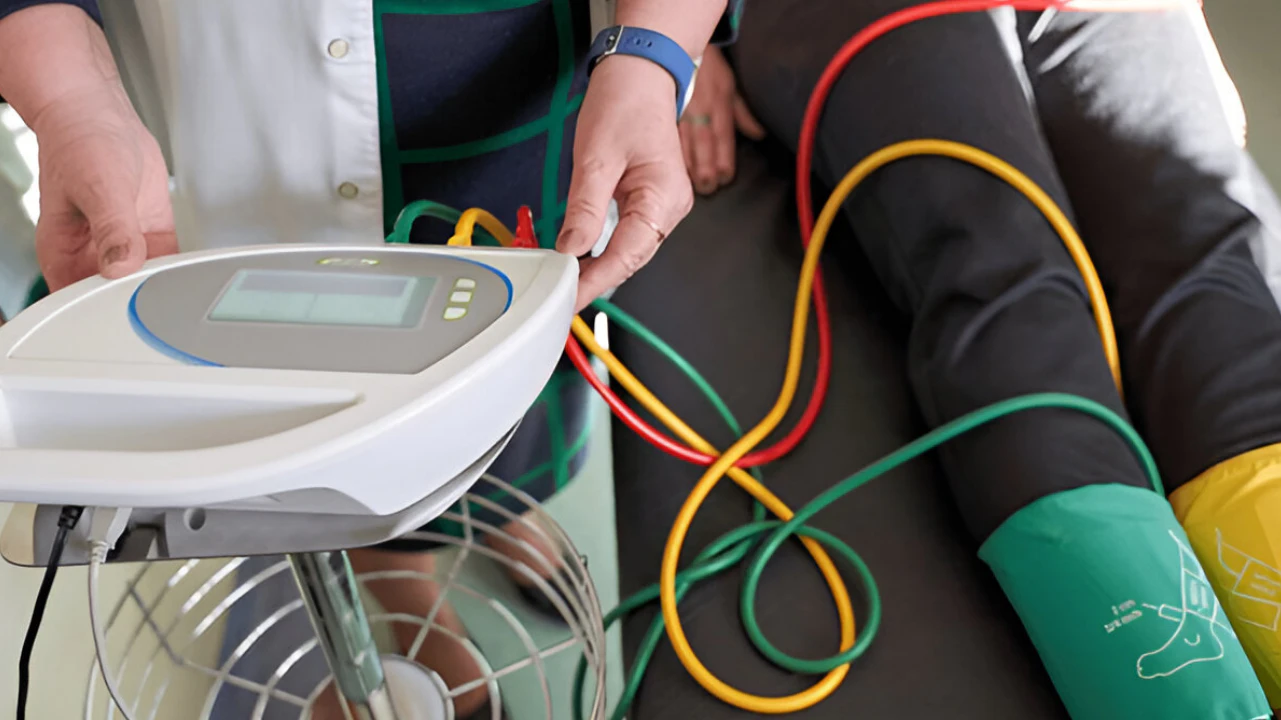Hey, friend! Ever wonder if there’s a quick way to check if your arteries are doing their job? You know, those hardworking tubes that shuttle blood all over your body? Well, let me tell you about something pretty amazing: the ankle brachial index test—or ABI for short. It’s like a little health detective that can spot trouble in your arteries, especially down in your legs. And guess what? There’s a cool machine that makes this test a breeze. Want to know more? Grab a comfy seat, and let’s chat about why this might just be the health tool you didn’t know you needed!
What’s This Ankle Brachial Index Test All About?

So, picture this: your arteries are like highways for your blood. When everything’s flowing smoothly, life’s good. But if there’s a traffic jam—or worse, a roadblock—it’s a problem. That’s where the ABI test comes in. It’s a simple check that compares the blood pressure in your arms to the pressure in your ankles. Why? Because if there’s a big difference, it could mean your leg arteries are narrowing, a sign of something called peripheral artery disease (PAD). PAD’s no joke—it’s linked to heart attacks and strokes if left unchecked. Scary, right? But don’t worry, this test is here to help us catch it early.
Why Should You Care About the ABI Test?
Okay, let’s get real for a sec. Have you ever felt your legs cramp up or get tired after a short walk? Maybe you brushed it off as “just getting older.” I get it—I’ve done that too. But PAD affects millions of folks, especially if you’re over 50, smoke, have diabetes, or deal with high blood pressure. The American Heart Association says about 8.5 million Americans have PAD, and a lot of them don’t even know it. Crazy, huh? The ABI test is like a superhero swooping in to spot the issue before it becomes a big deal. Early detection means you can tweak your habits or get treatment to keep your heart and legs happy. How awesome is that?
How Does the ABI Test Actually Work?
Now, you’re probably wondering, “How do they do this test? Is it complicated?” Nope, not at all! Imagine lying on a table, chilling out, while someone wraps blood pressure cuffs around your arm and ankle. Sometimes they use a little gadget called a Doppler ultrasound—it’s like a stethoscope for your blood flow—to listen to how your blood’s moving. The ankle brachial index machine then crunches the numbers and gives a ratio. Takes maybe 15 minutes, tops. No needles, no pain—just a quick squeeze from the cuffs. It’s like a mini spa session, minus the scented candles!
Meet the Ankle Brachial Index Machine: Your New BFF

Alright, let’s shine the spotlight on the real star here: the ankle brachial index machine. This isn’t your grandma’s blood pressure monitor (though I bet she’d think it’s cool too). It’s a smart, specialized device that makes the ABI test faster and more accurate. Think of it as a trusty sidekick for doctors, helping them figure out what’s going on with your arteries without breaking a sweat.
What Does This Machine Do, Anyway?
So, what’s the magic behind it? The ABI machine measures blood pressure at your arms and ankles, then calculates that all-important ratio we talked about. Some even use Doppler tech to “hear” your blood flow—like a tiny microphone picking up the whoosh of your arteries. It’s super precise, cutting down on guesswork. There are portable ones you might see in a small clinic, and fancier models in hospitals that can do extra tricks. Whether you’re a patient curious about your health or a doc looking for tools, this machine’s got your back.
Cool Features That Make It Stand Out
If you’re into gadgets—or just like knowing what’s what—here’s what to love about these machines. Accuracy is king; you want readings you can trust. Ease of use? Huge bonus—nobody’s got time for a clunky setup. Some are lightweight and portable, perfect for on-the-go testing, while others can save your data or link up to a computer. It’s like picking out a new phone—you want the one that fits your vibe. For me, I’d go for something simple yet reliable, because who needs extra stress, right?
Getting Ready for Your ABI Test

Now that we’ve geeked out over the machine, let’s talk about how you can get ready for the test. I know, medical stuff can feel intimidating—trust me, I’ve been there. But this one’s a walk in the park, and I’ve got some tips to make it even easier.
Prep Tips to Ace the Test
Before you head in, here’s the scoop: skip the coffee or cigarettes for at least 30 minutes beforehand. They can mess with your blood pressure, and we want the real deal. Wear comfy, loose clothes—think sweatpants, not skinny jeans—so the cuffs slide on easy. If you’re on meds, check with your doc about holding off for a bit. It’s like prepping for a big presentation—you want everything just right. Oh, and relax! Stressing out won’t help, and this test is no biggie.
What’s It Like During the Test?
When it’s go-time, you’ll lie back on a table—maybe even sneak in a little daydream while they set up. The nurse or doc will wrap those cuffs around your arm and ankle, maybe dab on some gel if they’re using the Doppler. You’ll feel a squeeze, kind of like a friendly handshake from the machine. I had mine done once, and I was all braced for something weird, but it was over so fast I barely noticed. It’s chill, painless, and honestly kind of neat to see in action.
Decoding Your ABI Test Results

Okay, test’s done, and you’ve got some numbers staring back at you. What now? Don’t sweat it—I’ll walk you through what they mean, step by step.
Normal vs. Not-So-Normal Numbers
The ABI test spits out a ratio, usually between 0 and 1.4. Here’s a handy breakdown:
| ABI Value Range | What It Means |
|---|---|
| 1.0–1.4 | All good—your blood’s flowing like a champ! |
| 0.9–1.0 | Borderline—might need a closer look. |
| Below 0.9 | Heads up—could be PAD knocking. |
| Above 1.4 | Stiff arteries alert—time for more tests. |
If you’re in that sweet 1.0–1.4 spot, high five! Below 0.9 might mean PAD, and above 1.4 could point to calcified arteries, common with diabetes. But here’s the thing: these numbers aren’t a verdict—they’re a clue. Your doctor’s the detective who’ll figure out the full story.
What If My Results Are Weird?
Let’s say your ABI’s off—don’t freak out, okay? It’s not game over. It might just mean more tests, like an ultrasound, to double-check what’s up. My buddy Mike got a low score once, and it turned out he just needed to ditch smoking and walk more. Now he’s good as new! Abnormal results are like a nudge to take better care of yourself—maybe eat more veggies or move around a bit. You’ve got this, and catching it early is half the battle won.
How Much Does an Ankle Brachial Index Test Cost?

Alright, let’s talk cash—because healthcare bills can feel like a punch to the gut. The ankle brachial index test cost varies, usually landing between $158 to $330. Where you live, the clinic or hospital, and your insurance all play a part. A study from MDsave pegs the fair price around $200, but it’s smart to call ahead and ask. Good news? Insurance often covers it if you’ve got PAD risk factors. So, don’t let the price tag stop you—it’s a small investment for big peace of mind.
Why You Might Want an ABI Test
So, why bother with all this? Well, if you’re over 50, a smoker, diabetic, or your legs ache when you walk, this test could be a game-changer. PAD’s sneaky—it can hide out with no obvious signs until it’s serious. But the ABI test shines a light on it early. Ever wondered why your legs feel like lead sometimes? This could be your answer. Plus, it’s fast and painless—why not give it a shot for your health’s sake?
A Little Story to Prove the Point
Let me tell you about my neighbor, Jen. She’s a total go-getter—always gardening or chasing her dog around. But she started feeling wiped out after short strolls. She laughed it off as “old knees,” but her doc suggested an ABI test. Turns out, early PAD was slowing her down. A few tweaks to her diet and some meds later, she’s back to ruling the neighborhood. That little test gave her a heads-up she didn’t expect—and it could do the same for you.
Wrapping It Up: You’ve Got the Power
So, there we go—the ankle brachial index machine and the test it powers. It’s a simple, brilliant way to keep tabs on your arteries and dodge big health hiccups like PAD. If your legs are hinting at trouble or you’ve got risk factors, chat with your doc about it. I know tests can feel daunting—I’ve been there—but this one’s a breeze and so worth it. You’re in charge of your health, and this tool’s here to help you shine. What do you think? Ever had an ABI test, or know someone who has? Drop your story below—I’d love to hear it!


















Leave a Reply
You must be logged in to post a comment.